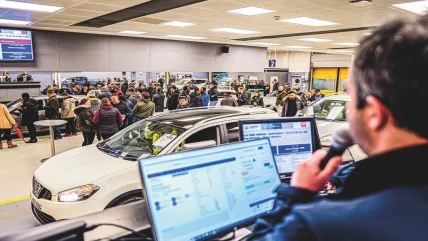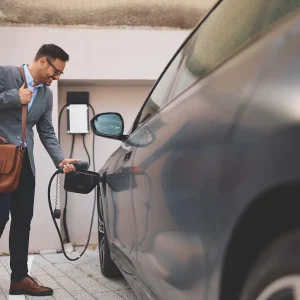
This is one of those articles that hangs on the disclaimer, ‘at the time of writing’. The used car market was in a funny old place when we put fingers to keyboard in late November, when wholesale values had been falling at an accelerated rate, but retail sale prices had yet to catch up.
Cap HPI issued a press release on 6 November – off-diary from its usual monthly updates – reporting that used car values had fallen a further 1.5% in the 10 days since its previous update on 27 October, when it said monthly values had fallen by 4.2%. That, it said, represented the largest drop in a single month since 2012 and the biggest fall since May 2011.
In the release, the firm cautioned that the market was “moving quickly” and admitted that monthly values were rapidly out of date. As did most market analysts, it described the overall move as a “realignment” after a prolonged period of inflated used car prices, which began to soften in April.
It reported another 4.2% monthly drop on 28 November but was quick to add that average values for petrol and diesel vehicles were around 15% higher than where they were at the start of 2021 for petrol and diesel vehicles, although average electric vehicles were around
20% lower.
Dealers and others disagreed with Cap’s October assessment, and there were heated exchanges on social media centred on the discrepancy between wholesale price drops and, at the time, the comparative strength of retail values.
“The headline figure doesn’t tell the whole story,” explains Philip Nothard, Cox Automotive’s insight director, “at times of realignment, you get a lag. It happened when EV values started to fall last October; the trade value is falling through the floor, and everyone’s going, ‘but retail isn’t’. That’s because you have a period of time where retailers are trying to manage their way through the [more expensive] stock.”
Nothard says this typically involves dealers making less profit on older used car stock and gradually adjusting prices of fresher models as they arrive, until the correlation between wholesale and retail prices syncs up. In short, it’s a game of tactics.
He adds there are pockets of the market doing better and worse than the aforementioned data suggests. In the former case, it is cheap used cars buoyed by the cost-of-living crisis, in the latter, it is manufacturers with aggressive new car sales targets.
“If you’ve got a sub-six-grand car, that’s retailable, the market can’t get enough of them,” he adds, “we’re now in a position where you can buy a brand-new car, and there are a lot of incentives – a lot of dealer contributions – and some of the manufacturers are putting on a lot of pressure.”
A lot of that is down to a regulatory burden to get higher-emitting models out the door before the end of 2023, which has brought back aggressive new car targets.
“We think there’s going to be quite a bit of forced registration activity by the manufacturers in December,” says Dylan Setterfield, Cap’s head of forecast strategy, “that’s where it gets quite difficult, because there will be some looking at CAFE regulations, there’ll be some looking forward and thinking about the zero emission vehicle mandate coming in January, and they may want to make sure they’ve got all their high CO2 cars registered in 2023 instead of having them in 2024 [and] they may want to hold electric vehicles into January.”
Demand for used cars has eased (again, see cost-of-living crisis/inflation for details) which has met head-on with an increase in leasing company defleets, themselves driven by greater availability of new models and a keenness to shift vehicles that were well overdue replacements. Though they are now making less money on used cars than they might have in the first half of 2023, leasing companies were not generally considered to be suffering losses because prices were still proportionately higher than the residual values set when the vehicles were new.
“They’re looking at what they had as a residual value on that car in 2020, and it’s ‘oh, I’ve got £5/6/7/8,000 to play with” adds Setterfield, “it is a lot easier for them, in that situation to accept lower bids for cars, and I think that’s one of the reasons why we’ve seen a much bigger drop than you’d normally expect in exactly the same situation any other time. There’s bigger aptitude for people to reduce their prices because of where they’ve got them in
the books.”
Nothard says he expects the used car market to end up with average depreciation of around 17.7% in 2023. For context, he tells us that seasonal average depreciation between 2005 and 2023 was 11%, that around 10-15% is generally considered normal, and that the 2008 financial crash created a 34.6% fall.
Predictions are that the 2024 used car market will be much closer to its old self than anything we have seen this decade, and those in the know are talking about typical seasonality and depreciation levels. The question – again, at the time of writing – is when that will start, because all of the above has led to sluggish dealer interest in wholesale stock. The assumption is that buying, at least, will kick into gear at some point in December or January.
Citing anecdotal conversations with trade buyers, Shoreham Vehicle auctions MD, Alex Wright, explains that buying bans contributed to slowing the late-2023 used car market, but he is confident it will be in for a good start in 2024.
“Some dealers haven’t bought cars at auction for several weeks, while others have been restricted to four-to-five per auction visit. Dealers are also retailing fewer used cars at higher prices, which has also contributed to falling auction conversion rates.
“Dealer groups will be buying stock again in December. and the used market will take some strong momentum into 2024.”
“The thing we always get asked about at this time of year is the January bounce,” adds Setterfield, “there isn’t such a thing as a January bounce. Prices almost always go down; they just don’t go down very much. You get more activity, so it feels like things are better, but 2020 and this year are the only years when we’ve had positive movements January into February. If you called it, on average, minus a half, that’s always going to be pretty close.”
He believes that March/April will herald the first notable rise in values, due largely to a paucity of three-to-four-year-old cars.
“March into April is the first month when it gets better. the further we go into the year, we are going to start to see the difference because of the cars that weren’t registered in the pandemic. [and] when you track that forward, we are going to get a massive shortfall in a very short space of time. You’ll go from having about one-and-a-quarter million vehicles over the last 12 months to only having 850,000.
“It’s about February when it starts to move rapidly in the space of a couple of months. Cars are going to be in very much lower supply, and we’re already seeing it in the leasing returns. You can see that four and five-year-old cars from 2018/2019, instead of being 5% [of the market], they’re now 15%. And the proportion of cars from two to three years ago – 2020/2021 – instead of being up near 25%, that’s down below 10%. You have this big switch in the proportion of cars available in the marketplace, and it’ll be that three to four-year-old part that’s going to be where we’re going to start to see big reductions in volume through the next 12-24 months. There’ll be far fewer of those cars about.”
Supported by:






